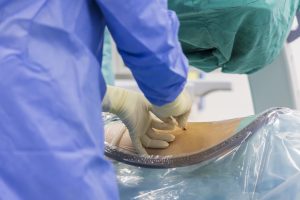IMPROVING LIFE, ONE PATIENT AT A TIME

Transforaminal Epidural Steroid Injection (TFESI)
The pain caused by spinal stenosis and herniated discs can be quite significant. One of the ways we can help relieve that pain is through use of something known as the transforaminal epidural steroid injection (TFESI). This is an outpatient procedure that offers longer-lasting pain relief and can actually help promote healing in some patients.
You may have heard of epidural injections relating to labor and delivery. The word ‘epidural’ means ‘upon the dura mater’. In simple English, it means ‘around the spine’. TFESI procedures are intended to do two things:
- Identify the site of the injury causing pain; and
- Relieve the pain by reducing inflammation.
Transforaminal epidural steroid injections are considered safe and efficacious. They can be applied in the cervical, thoracic, and lumbar regions of the spine and can involve both anesthesia and steroids.
What causes the pain a Transforaminal Epidural Steroid Injection are used to treat?
A TFESI procedure is generally intended to treat pain caused by nerve compression. In cases of herniated discs and spinal stenosis, nerves are being compressed within the spinal column. This causes pain that can radiate out from the location of the compressed nerves.
For Example, in the case of a herniated disc in the cervical spine, pain is normally felt in the neck and corresponding shoulder. Additional pain, numbness, and weakness can radiate down the arms into the hands.
How does a TFESI work?
 After identifying the actual site of the nerve compression, the steroids involved in a TFESI procedure bathe the area and reduce inflammation. As inflammation goes down, pressure on the affected nerve is also reduced. The result is less pain. In some cases, reducing the inflammation is enough to allow the body to naturally heal itself.
After identifying the actual site of the nerve compression, the steroids involved in a TFESI procedure bathe the area and reduce inflammation. As inflammation goes down, pressure on the affected nerve is also reduced. The result is less pain. In some cases, reducing the inflammation is enough to allow the body to naturally heal itself.
How is the procedure performed?
Before any injection takes place, the doctor will locate the site of the injury using a fluoroscope. This is a specialized kind of x-ray machine that allows the doctor to see real-time images of the patient’s spine. Moreover, these are moving images rather than static pictures.
Next, a local anesthetic is used to numb the skin and the tissue down to the surface of the spine. A thin needle is then inserted into the numbed tissue in preparation for the steroid injection. The doctor then returns to the fluoroscope to guide the needle into just the right position, where steroids are injected into the foraminal epidural space.
Finally, the needle is removed, and the site is covered with a bandage. The patient is monitored for a short amount of time to ensure proper recovery. The entire procedure takes 20 to 30 minutes; most patients return home the same day.
What can patients expect following the Transforaminal Epidural Steroid Injection?
It is not unusual for patients to experience soreness at the site of injection for a day or two following a TFESI. Doctors generally recommend patients rest for the remainder of the day. They can resume full activity the following day. As for pain relief, patients tend to begin noticing a difference within a week.
Some patients require two or three injections to experience maximum pain relief. In such cases, injections are spaced several weeks apart over a six-month period.
Note that TFESIs do not correct the underlying condition. They are often used in conjunction with other treatments in order to provide maximum pain relief. Your doctor might recommend TFESI’s along with physical therapy and/or medication, for example.
For more information about TFESIs, contact Lone Star Pain Medicine. We are more than happy to discuss whether or not this treatment is right for you.
